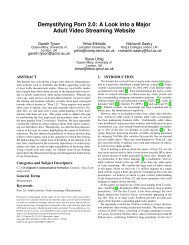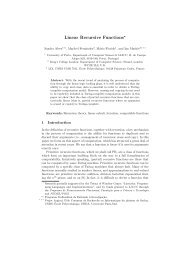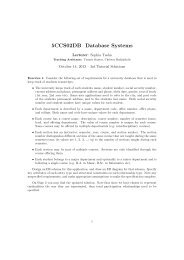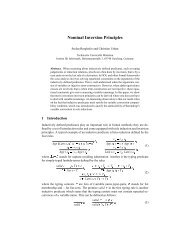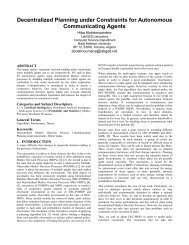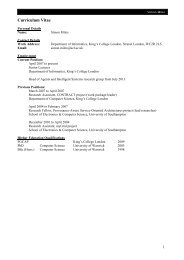Upgrade Report - Department of Informatics - King's College London
Upgrade Report - Department of Informatics - King's College London
Upgrade Report - Department of Informatics - King's College London
- No tags were found...
You also want an ePaper? Increase the reach of your titles
YUMPU automatically turns print PDFs into web optimized ePapers that Google loves.
7 GRAPH GENERATION 20(a) Constant m = 3 Varying s(b) Constant s = 50 Varying mFigure 7: Comparison <strong>of</strong> different parameter effects on undirected random walk graphs N = 500007.2 Preferential attachment and message propagationThis model is essentially a combination <strong>of</strong> the well known preferential attachment model with an intuitiveflavor <strong>of</strong> the Twitter link creation procedure. The idea is that there are two ways <strong>of</strong> creating links. The firstway is the traditional undirected preferential attachment on a directed graph where a new vertex joins andconnects to m other vertices with probability proportional to each vertex’s total degree. The alternativeway is that an existing vertex activates and begins transmitting a message down to its out-edges. Eachrecipient <strong>of</strong> that message has a probability p to retransmit that message. After the process has died out (orreached a maximum number <strong>of</strong> hops) then from all the vertices which retransmitted, m <strong>of</strong> them choose tocreate a link to the originator <strong>of</strong> the message.One variation <strong>of</strong> this model consists <strong>of</strong> two phases. The first phase is the growth phase, which is thesame process as in the preferential attachment model. The second variation <strong>of</strong> the model alternates betweena preferential attachment step and a message propagation step until the graph reaches a desired size.The the message propagation (or densify) phase, which consists <strong>of</strong> N steps (N being the number <strong>of</strong>vertices <strong>of</strong> the graph), performs the following per step:1. Given the vertex u i where i is the current step (i ≤ N) add < u i , 0 > to a queue Q where h = 0represents the current number <strong>of</strong> hops h2. Let q =< u, h > be an entry in our queue. Do the following while the queue Q is not empty• Remove q from Q.• ∀v j : ∃e j = (u, v j ) : With probability p add v j to a list L and < t i , h + 1 > to Q ∀e i = (u, t i )• The above step will be performed until Q is empty.3. Select m vertices {w 0 , · · · , w m } UAR from L and create edges e j = (w j , u i ) 0 < j ≤ mHere we would like to point out that during first step <strong>of</strong> the message propagation (or densify) procedurewe expect pm vertices to retransmit the message. If pm ≥ 1 then with high probability the process willnever terminate. For that reason we have two different ways <strong>of</strong> ensuring termination. The first is to neveradd the same vertex to Q or L more than once, which would mean that it will terminate after at most NMsteps (where M is the number <strong>of</strong> edges). The second is to have an upper bound on the maximum hopsh max for which we will add items in the queue, which will constrain the number <strong>of</strong> steps to p ∑ h maxi=1m i . Inpractice both these methods are used to optimize both for time and space performance where h max = 16 inthe example we will be presenting.The first variation <strong>of</strong> the above process generates power-law degree distributions on both the out-degreesand in-degrees as seen below. Additionally some sort <strong>of</strong> community structure is created with the modularityQ ranging between 0.25 and 0.5. It is empirically observed that p affects Q but we have not yet determinedhow and why this occurs. However intuitively we assume that the aspect <strong>of</strong> the model which generatesthe community structure is the densification and we would expect that values <strong>of</strong> p such that pm = 1 willresult in a higher success rate <strong>of</strong> message propagations while limiting the number <strong>of</strong> hops that the message



